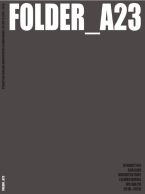Zeszyt dydaktyczny Zakładu Architektury Elementarnej IPA WA PK pt. Folder A-23 to wydawnictwo podsumowujące dorobek dydaktyczny z lat 2016–2020 w ramach projektowania wstępnego na 1 roku (1 i 2 sem.), na projektowaniu architektoniczno–urbanistycznym zespołów mieszkaniowych (na 3 roku I st. oraz na 1 roku II st.), seminarium specjalistycznym oraz projektowaniu dyplomowym.
Program i zakres nauki w ZAE A-23 jest odzwierciedleniem nazwy jednostki oraz zasady nauczania studentów – elementarność to najlepszy sposób na powrót do źródłowych znaczeń architektury, do myślenia o architekturze i mieście w bazowym, podstawowym znaczeniu, ukazującym istotę poszczególnych składowych. Takie nauczanie nie może obyć się bez racjonalnych podstaw analizowania formy, struktury, funkcji, konstrukcji oraz ich odniesień geometrycznych i materialnych. Elementarne to znaczy także wyznaczone konsekwentnym i logicznym procesem kontrolowania równowagi nad biegunami architektury oraz architektury miasta – ogólnym i szczegółowym.
Wskazywanie tego co najprostsze (zredukowane, skromne, niepodzielne) jest nie tyle wyzwaniem dydaktycznym, co również, okazuje się, wyjątkową drogą do nauczania oraz poszukiwania niezmienionych od wieków sensów oryginalności architektury prostoty.
Didactic Journal of the A-23 chair of elementary architecture at the Faculty of Architecture, CUT titled Folder A-23 is a publication that summarizes didactic achievements between 2016 and 2020 as part of preliminary design course in 1st year (1st and 2nd sem.), architectural and urban design of residential complexes (3ʳᵈ year of first-cycle degree programme and 1ˢᵗ year of second-cycle degree programme), specialist seminar and diploma design.
The curriculum and scope of education in A-23 chair of elementary architecture correspond to the name of the unit and the principles of teaching students – elementariness offers the best way to return to the source meanings of architecture, to thinking about architecture and the city in the basic, fundamental meaning – revealing the essence of individual components. Such teaching cannot be done without a rational framework for the analysis of form, structure, function, construction and their geometric and material references. Elementary also means designated by a consistent and logical process of controlling the balance over the poles of architecture and the architecture of the city – both general and detailed one.
Indicating that which is simplest (reduced, modest, indivisible) is not merely a didactic challenge, but it also turns out to be a unique way of teaching and searching for the meanings of originality in the architecture of simplicity invariable for centuries.
